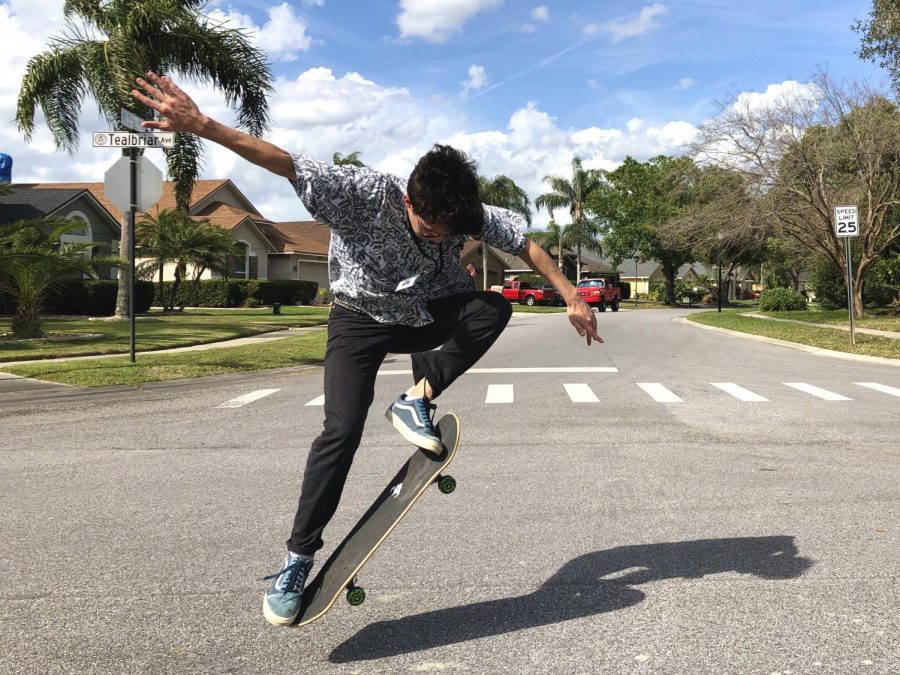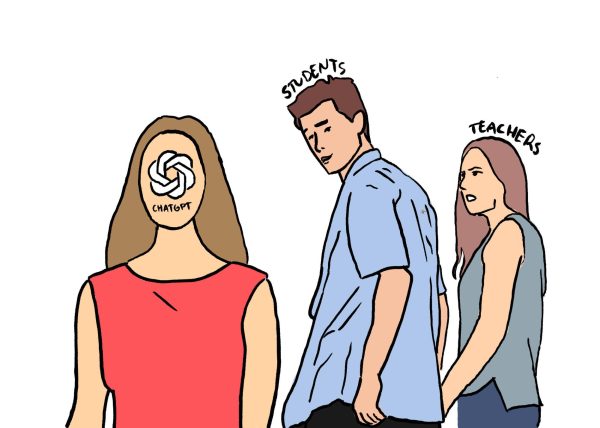Pride of the ride
photo by Lukas Goodwin
Junior Jackson Schwerdt performs an ollie, a popular trick many skateboarders learn. He usually practiced a few times a week for a couple hours.
When he was still in middle school, sophomore Vincent Connelly often hung out with his older brother and his skater friends. Spending so much time with them, and being an impressionable younger sibling that looked up to his brother, Connelly quickly picked up skateboarding as well. Since then, it has become a large part of his life.
“I would always hang out with my brother, so I’d watch them skate too and then I got into it,” Connelly said. “He’s inspired me a lot in that way.”
Having to maintain balance and speed while performing complex tricks can intimidate newcomers to skating. But while the danger of it dissuades many, others like senior Chris Tabares embrace the thrill.
“Fear in skateboarding is essential, but that’s what makes it so fun,” Tabares said. “It gives you an adrenaline rush but it also teaches you how to get back up.”
There are two main types of boards: regular skateboards, which are smaller, faster and better for tricks, and longboards, which are larger and optimal for riding smooth, long distances. Usually, regular boards are more popular, but junior Jackson Schwerdt started off with a longboard.
“I got into it when I found my longboard in my garage and I started skating around my neighborhood,” Schwerdt said. “I still do tricks on it… it’s just not originally intended to do that.”
Regardless of what they start with, all skaters will face a learning curve. Passionate skaters will spend hours upon hours practicing, but for just getting started, something all skaters must retain is patience and dedication.
“You’ll fall off a couple times,” Connelly said. “But if you skate for three or four hours once a week, you should be straight.”
That amount of dogged practice is usually spent learning a variety of tricks, such as the ollie (in which the skater and board leap into the air), kickflip (rotating the board 360 degrees along its axis) and heelflip (a kickflip, but rotated via the front of the board).
“They all take a really long time to learn,” said senior Julian Weremchuk. “There’s definitely a progression: you learn one trick, and then you pretty much unlock the next trick. Right now I’m learning how to do a heelflip.”
The versatility of the sport encourages skaters to make it their own. Some may find comfort in the inherent solitude of it, but others see it as a communal activity. Tabares feels the individualism of skateboarding is how people hone their skill, but the shared culture is where it thrives.
When he was new to skating, Tabares discovered the UCF Skateboarding Club, which meets every Tuesday night on campus. Although it is organized by college students, high schoolers like Weremchuk and Tabares meet with them regularly, and all are welcome to join.
“Skateboarding is a really big community,” Tabares said. “I remember… one day I saw a bunch of people skating at UCF, and they told me about the club, and then little by little I started going there every Tuesday.”
The culture behind skateboarding is another large aspect that draws people in. Popular companies like Vans, Converse and Dickies all originated as skate brands, but now they help put the sport into the limelight.
“Especially on the west coast, there’s a lot of fashion influence. That’s how brands like Supreme and Thrasher go really big… being leaked into the mainstream,” said Weremchuk. “I definitely recognize and appreciate it.”
With a rise in publicity, skateboarding is significantly more widespread than it has been in the past. For the first time in history, there will be two official skating competitions, park and street, in the 2020 Tokyo Summer Olympics.
“It’s really cool that that’s happening this year,” Connelly said. “It’s a big deal, because that really makes it like a certified sport.”
At its core, people love skateboarding for its speed and intricacy. The rest of the world gets to share that excitement through clubs, fashion or watching the Olympics, but the sport can also feel liberating for skaters.
Whenever bogged down with the stresses of life, they know they can always return to skating to let loose and have fun.
“Skateboarding is kind of an escape from [stress],” Schwerdt said. “If I don’t have enough time to skate, I won’t skate. But when I do get the chance, it really helps me reconnect with what I love to do.”
Your donation will support the student journalists of Hagerty High School. Your contribution helps us publish six issues of the BluePrint and cover our annual website hosting costs. Thank you so much!










